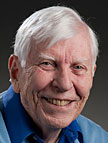- Number 341 |
- July 11, 2011
-
NREL invention speeds solar cell quality tests
 To come up with a way to do something 1,000 times faster than it had been done in the past, you have to count on some serendipity – not to mention hard work, collaboration and good timing.
To come up with a way to do something 1,000 times faster than it had been done in the past, you have to count on some serendipity – not to mention hard work, collaboration and good timing.
Such was the case with three scientists from DOE’s National Renewable Energy Laboratory, who somewhat accidentally developed a way to assess the quality of solar cells at a speed that is orders of magnitude faster than had been done before.
-
The choices that ions make
 From renewable energy to pharmaceuticals, iodide ions are a common but poorly understood actor, but scientists at DOE’s Pacific Northwest National Laboratory have found a way to learn more about iodide and better predict its behavior. The trick is to consider the less obvious choices of the electrons in the ion. Using this elegant and complex approach, Dr. Chris Mundy and Dr. Marcel Baer showed the ion congregates at the air-water interface at lower concentration than previously predicted. Better understanding of the electrons and the associated ion movement could change long-held assumptions and open new doors for basic energy research and climate studies.
From renewable energy to pharmaceuticals, iodide ions are a common but poorly understood actor, but scientists at DOE’s Pacific Northwest National Laboratory have found a way to learn more about iodide and better predict its behavior. The trick is to consider the less obvious choices of the electrons in the ion. Using this elegant and complex approach, Dr. Chris Mundy and Dr. Marcel Baer showed the ion congregates at the air-water interface at lower concentration than previously predicted. Better understanding of the electrons and the associated ion movement could change long-held assumptions and open new doors for basic energy research and climate studies.
-
Seeing the Effects of Rock Heterogeneity on CO2 Movement
 All three DOE's National Energy Technology Laboratory X-ray CT scanners were recently used to characterize flow patterns during CO2 flooding of a sandstone sample from China. This work was part of a U.S.-China Energy Partnership that involves the Chinese Academy of Sciences (CAS), NETL, and PNNL. A delegation of scientists from the CAS brought a core sample from a sandstone formation in the Ordos Basin, China, that is of interest for potential CO2 storage.
All three DOE's National Energy Technology Laboratory X-ray CT scanners were recently used to characterize flow patterns during CO2 flooding of a sandstone sample from China. This work was part of a U.S.-China Energy Partnership that involves the Chinese Academy of Sciences (CAS), NETL, and PNNL. A delegation of scientists from the CAS brought a core sample from a sandstone formation in the Ordos Basin, China, that is of interest for potential CO2 storage.
-
Neutrons, simulations reveal details of bioenergy barrier
 A first of its kind combination of experiment and simulation at the DOE's Oak Ridge National Laboratory is providing a close-up look at the molecule that complicates next-generation biofuels.
A first of its kind combination of experiment and simulation at the DOE's Oak Ridge National Laboratory is providing a close-up look at the molecule that complicates next-generation biofuels.
Lignin, a major component of plant cell walls, aggregates to form clumps, which cause problems during the production of cellulosic ethanol. The exact shape and structure of the aggregates, however, have remained largely unknown.


